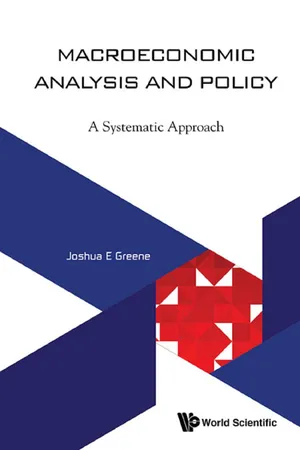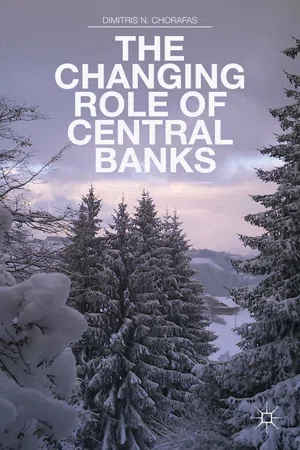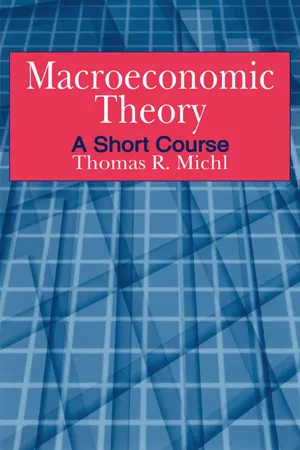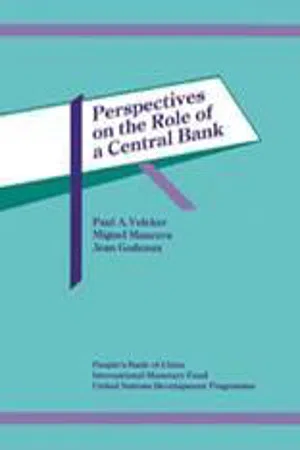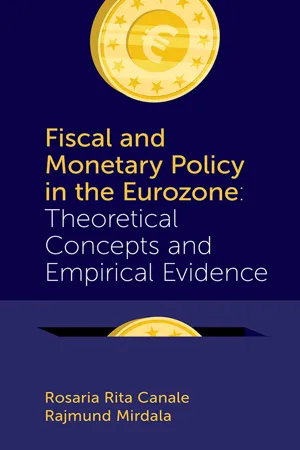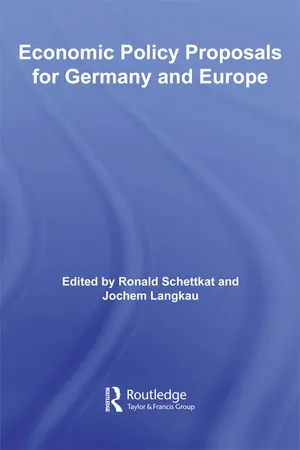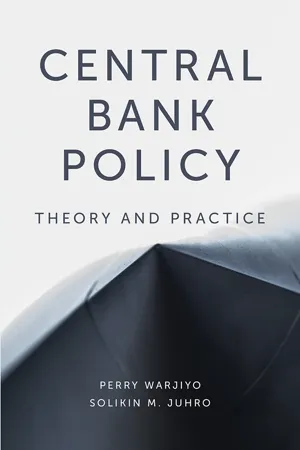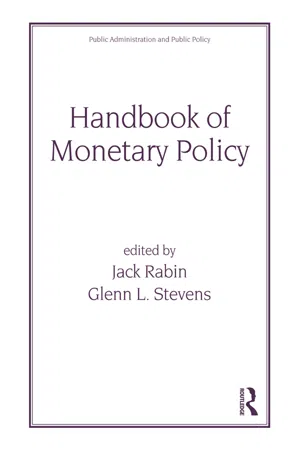Economics
Monetary Policy Curve
The monetary policy curve represents the relationship between the interest rate and the level of economic activity. It illustrates how central banks adjust interest rates to influence economic growth and inflation. As interest rates rise, borrowing becomes more expensive, leading to reduced spending and economic activity, while lower interest rates can stimulate economic growth.
Written by Perlego with AI-assistance
Related key terms
Related key terms
1 of 4
Related key terms
1 of 3
10 Key excerpts on "Monetary Policy Curve"
- eBook - ePub
Macroeconomic Analysis and Policy
A Systematic Approach
- Joshua E Greene(Author)
- 2017(Publication Date)
- WSPC(Publisher)
Chapter 8MONETARY POLICY
Monetary policy involves the use of certain policy instruments, typically interest rates, to achieve short- and intermediate targets as a way of attaining broader objectives, such as a desired rate of inflation. Figure 8.1 describes the basic framework for monetary policy, regardless of the particular policy regime the monetary authority uses.Beginning in the upper left-hand corner of Figure 8.1 , the monetary authority takes a policy decision and uses instruments to set an operating target — typically a very short-term interest rate, such as that in the overnight money market. The instruments involve activities such as open market operations (buying and selling government securities or its own securities to deposit money banks, sometimes through repurchase (“repo”) or reverse repurchase (“reverse repo”) operations), changing its discount rate, or changing reserve requirements. The monetary authority sets the operating target as a way of attaining an intermediate target — the growth rate of broad money, the exchange rate, or a forecast rate of inflation — in order to achieve an ultimate policy objective, such as a targeted rate of inflation. After attaining its operating target, the monetary authority reviews a broad set of indicator variables, to see how the economy has responded to its actions. Depending on the values of these variables, the authority decides whether to keep policy unchanged or make further changes to its operating target.FIGURE 8.1. BASIC FRAMEWORK FOR MONETARY POLICYI. GENERAL DESCRIPTION OF THE FRAMEWORK FOR MONETARY POLICY
A. The Monetary Policy Objective
Monetary policy can focus on price stability, exchange rate stability, or minimizing the variability in real output - eBook - ePub
- D. Chorafas(Author)
- 2013(Publication Date)
- Palgrave Macmillan(Publisher)
An important role might also be played by unconventional measures in the central bank’s arsenal and their impact on market psychology. Market psychology is as well affected by issues that are, so to speak, unobservable but inferred from a host of secondary variables, anecdotal evidence, rumors, and expectations of the central bank’s future moves. Basic ingredients of a monetary policy are:• Amount of money within a jurisdiction (monetary base as distinct from money supply, section 2),• The definition of bank reserves,• Velocity of circulation of money,• Interest rates,• Exchanges rates,• Inflation or deflation, and more.In general, whatever affects a currency’s stability and public acceptance in the global market comes under the realm of monetary policy, which economists debate as being sound or questionable, firm or ambivalent, clearly stated or uncertain. No monetary policy will find everyone being in accord with its direction and details.The aftermath of a flawed monetary policy extends well beyond economics and into society’s preoccupation with business activity, employment, stability, and improvement in the standard of living. Moreover, the influence of the monetary policy is mitigated by the economic policy and the fiscal policy. In the large majority of cases employment is not one of the objectives in the charter of the central bank. Among major nations the notable exception is the US Federal Reserve whose status was amended by Congress in the late 1960s to target both:• Currency stability, and• EmploymentCurrency stability is possible only if well-done economic policies and spontaneous market forces are geared to maintaining it. If not, what usually takes place is tortuous economic adjustments that, over time, might bring about a sense of stability. More often than not, however, a wrong-way monetary policy sees to it that monetary stability1 is and remains an elusive goal.In contrast to monetary policy, the fiscal policy - eBook - ePub
Macroeconomic Theory: A Short Course
A Short Course
- Thomas R. Michl(Author)
- 2015(Publication Date)
- Routledge(Publisher)
When inflation is high, the central bank responds with high interest rates to increase unemployment, leaning against the inflation wind. The position of the central bank reaction function reflects this tighter monetary policy. In practice, the central bank would reduce the money supply in order to raise interest rates. High interest rates choke off investment and reduce aggregate demand, which raises the unemployment rate. When inflation is low, the central bank loosens up on the money supply to let interest rates fall and lower the unemployment rate. In this theory, the central bank basically chooses a position along the IS curve, depending on how much inflation prevails.With respect to policy initiatives, the dynamic AD curve with active monetary policy behaves much like the static AD curve. Fiscal policy, or any parameter change that shifts the IS curve, results in shifts in the dynamic AD curve. A stimulative fiscal policy will shift the dynamic AD curve to the left, or inward, since it will lead to lower unemployment. A fundamental change in the monetary regime also shifts the dynamic AD curve. For example, if the central bank decided to get tough on inflation, we might model that as an increase in the parameters h0 or h1 . The dynamic AD curve would shift to the right, signifying monetary tightening.This theory is both easier to understand and more realistic than the theory of the static AD curve. It describes well the drama of monetary policy as it is played out in public.11.4 Target inflation and policy rules
We can use Equations (11.2 and 11.3) to determine the long-run equilibrium values of the interest rate and the long-run equilibrium rate of inflation.11.4.1 The natural rate of interest
By substituting Yninto Equation (11.3), we can see that the long-run value of the real interest rate is:r n=a 0−Y na 1Here the n subscript is mnemonic for the natural rate of interest, which is another term for the long-run equilibrium real rate of interest. The natural rate of interest is unaffected by monetary policy. However, it is capable of being changed by fiscal policy, since it depends on the parameters of the IS curve. For example, an increase in government spending will shift the IS curve outward by increasing the parameter a0 - eBook - ePub
Balance of Payments
Theory and Economic Policy
- Robert Stern(Author)
- 2017(Publication Date)
- Routledge(Publisher)
By monetary policy, we shall mean simply an increase in the stock of money, M*, assuming government expenditure unchanged. In the case of both monetary and fiscal policy, the interest rate must change to equilibrate the system. Expansionary fiscal policy can thus be represented diagram-matically by an upward shift of the IS curve and expansionary monetary policy by a downward shift of the LM curve. Neither policy instrument operates directly on the B curve, although as just noted, this curve, as well as the IS and LM curves, will shift if the exchange rate is altered as a result of policy changes. Monetary and Fiscal Policies Under Fixed Exchange Rates Suppose now that the exchange rate, r, is fixed, and a stabilization authority with official reserves buys and sells foreign exchange to maintain that rate in cases of balance-of-payments surplus and deficit. In addition to the general assumptions made so far—including the assumption of no foreign repercussions—let us assume initially that changes in official foreign exchange reserves are not allowed to affect the money supply. Such changes are sterilized, which is to say that if the stabilization authority is absorbing foreign exchange in return for domestic currency, the monetary authority is engaging in open market sales at the same rate. The converse is assumed to be the case when foreign exchange is being sold by the stabilization authority. In Figure 10.4, the IS, LM, and B curves (for B = 0) are depicted with a mutual intersection at P. At this point, the economy will be in internal balance, although not necessarily at full employment, and in external balance, since B = 0 - eBook - ePub
- Miguel Mancera, Paul Volcker, and Jean Godeaux(Authors)
- 1991(Publication Date)
- INTERNATIONAL MONETARY FUND(Publisher)
Obviously, monetary policy authorities like to do good in all situations. They would like to see the economy operate with growth, full employment, balance of payments equilibrium, and price stability. We all want to be wise and flexible and adjust our policy instruments to achieve all of those objectives. But I am not sure that that is saying much more than as intelligent, humane people we want to do good. The question is whether we can always do good in all directions at the same time. Monetary policy is an important aspect of economic policy, but it is only one instrument of economic policy.The unique characteristic of monetary policy is that it deals with money and, in dealing with money, it inevitably deals with markets. Money itself produces nothing, but without money there cannot be efficient markets, and, conversely, without reasonably efficient and effective markets, there is no real purpose in monetary policy. What is important, if we are going to have well-functioning markets, is that there be some sense of monetary stability. Without a sense of monetary stability, I do not think we can have a very effectively operating economy—one in which other participants can produce, will be willing to save, will be willing to invest in the future, and will be able to trade freely with other countries.I am using monetary stability in a very broad sense. I am thinking of reasonable stability in exchange rates. I am thinking of continuity in financial markets so that one can plan today what might reasonably happen tomorrow. I am thinking of encouraging performance on financial contracts and providing for the repayment of debts on a planned basis, of providing for a basis for lending on reasonable terms, and, when I think of monetary stability, I am thinking, above all, of price stability.A point that I would like to emphasize is that monetary stability is the first priority of monetary policy, and, when there is a choice of objectives, that is the one that should be emphasized. What that means more broadly is that central banking and monetary policy require a constant sense of placing limits on money and credit creation. Those limits may change from time to time depending upon economic circumstances, but we must always think in terms of appropriate limits because, when money and credit creation is excessive, we will lose the monetary stability necessary for economic activity to perform optimally. That does not put central banks in a very popular position. One of my colleagues as chairman of the Federal Reserve Board used to put the point very simply: he said the function of monetary policy and the function of a central bank was to take away the punch bowl just when the party got good. Another American commentator, in a rather critical way, described a central banker as a person who is always fearful that someone else may be happy. The fact is that the function of the central bank is to set limits, to set a framework—which other people may not like—that provides an environment in which growth and stability may be achieved in the interest of the economy as a whole. - eBook - ePub
Fiscal and Monetary Policy in the Eurozone
Theoretical Concepts and Empirical Evidence
- Rosaria Rita Canale, Rajmund Mirdala(Authors)
- 2019(Publication Date)
- Emerald Publishing Limited(Publisher)
Fig. 3.4 ). From a monetary policy point of view, the interest rate at which the economy is at the full employment refers to the natural interest rate, while the current interest rate refers to the market interest rate. Considering this, the traditional objective of monetary policy is to preserve a convergence of the market interest rate to the natural interest rate while at the same time to achieve and maintain the price stability in the economy. If, under such conditions, the central bank conducts its responsible monetary policy, the nominal money supply will tend to rise during the recession and, similarly, to decrease during expansion.By contrast, Friedman has come to the conclusion that the nominal money supply tends to develop pro-cyclically and therefore tends to grow in the expansion and declines in the recession. Based on this finding, Friedman noted that central bank activities lead to cyclical fluctuations in the economies rather than diminishing and mitigating the negative effects of cyclical development. At the same time, Friedman found that the evolution of the amount of money in circulation influenced economic activity in the country over the long term.One of the main monetary policy issues is that the monetary authorities cannot predict the economic development in the country with sufficient advance to implement an appropriate monetary policy. Considering that statistical data on economic development are usually reported quarterly, the “current” data available to the central bank are usually three months old and therefore it is rather difficult to estimate whether the economy at the “present” is in the phase of recession or expansion. The “current” state of the economy can only be estimated by the central bank on the basis of data available in the next quarter. Given the time lag with which the increase in nominal money supply affects economic development, it is almost impossible to formulate a general framework for optimal counter-cyclical development of the amount of money in circulation. - eBook - ePub
- Ronald Schettkat, Jochem Langkau(Authors)
- 2008(Publication Date)
- Routledge(Publisher)
3 Monetary policy and the real economyPaul De Grauwe and Cláudia Costa Storti
Introduction
How effective is monetary policy in influencing output and employment? How long do the effects of monetary policy last? These questions have been hotly debated. In the 1970s and 1980s, they led to a major schism in the economics profession between Monetarists and Keynesians. This schism seems to have been resolved now, and a mainstream view can be said to have emerged.The mainstream view today has been influenced by several theoretical developments. First, there is the real business cycle theory, which has introduced the idea that macroeconomic models should be based on sound micro-foundations in which individual agents continuously maximize their utilities in a dynamic framework and in which these agents understand and use the full complexity of the underlying model in forecasting the future (rational expectations). Second, building on this methodological innovation, macroeconomists have introduced price and wage rigidities into their models. This has led to the so-called Neo-Keynesian models in which representative agents optimize their utilities and have rational expectations but face some constraints in that they cannot adjust prices and wages instantaneously (see e.g. Clarida et al. 1999; Christiano et al. 2001). This last feature provides the basis for monetary policy to affect output and employment.These theoretical developments have led to the consensus view, first, that monetary policy has significant short-term effects on output and employment; second, that these effects are temporary. This consensus can be represented by a hump-shaped curve showing the time profile of the effect of an unexpected decline in the short-term interest rate on output. This curve is typically obtained from an impulse response analysis of the effect of an unanticipated decline in the short-term interest rate in an empirical version of Neo-Keynesian macroeconomic models (see e.g. Smets and Wouters 2003; Walsh 2003). Much of the discussion, today, among macroeconomists has shifted to the issue of whether this empirical regularity can be exploited by the monetary authorities and whether rules should govern the conduct of monetary policy. - Pawel Bozyk(Author)
- 2019(Publication Date)
- Routledge(Publisher)
Indirectly, the policy of a change ol the interest rate exerts a significant impact on the interest of foreign capital in investments in a given country. A real growth of incomes on deposits in the domestic currency encourages foreign capital to make deposits in this currency and, conversely, a decline of real incomes on deposits in the domestic currency contributes to an outflow of foreign capital. Consequently, the balance of capital turnover changes, followed by the balance of payments. A comparison of the income possible to be achieved in virtue of interest requires, however, knowledge of the predicted changes in the exchange rates of individual currencies and relations between these changes. Devaluation of a given currency (the same as its appreciation) leads to a reduction of the real income on deposits in a given currency, independent of the interest rate and. conversely, revaluation (like appreciation) leads to a growth of the real income on deposits. This is followed by an increase or a decrease of interest in holding deposits.3.4. Monetary Policy
Money is all and any means of exchange and means of payment, the ability of which to pay is unlimited both when goods or services are bought and when financial liabilities towards a creditor, a bank, central budget, local budget, and the like are settled. It performs an essential role both in the economic policy of individual countries and in their foreign economic policy.17 As a measure of value, means of circulation, means of payment and means of accumulating reserves, money facilitates the process of exchange, also including international exchange. Without money, the scale of this exchange would be much smaller and its costs much higher. Simultaneously, money facilitates the development of other forms of economic activity, including production, scientific and technical research, and the like. Without money, cooperation in production, investments, science and technology on an international scale would be impossible.In a market economy, the monetary policy is pursued by the central bank.18- eBook - ePub
Central Bank Policy
Theory and Practice
- Perry Warjiyo, Solikin M. Juhro(Authors)
- 2019(Publication Date)
- Emerald Publishing Limited(Publisher)
Second , the analysis of monetary policy rules does not have to reflect optimal central bank behavior. If the objective of the analysis is to seek an optimal policy, then the design of the policy rule should be produced from optimization measures that refer to the function of the central bank’s goal, which is based on public utility or behavior; where, in practice, no central bank explicitly states the objective function. Therefore, not all analyses recommended for use must assume optimal measures from the central bank. In this case, it is reasonable to expect positive analysis, examining the impact of hypothetical rules that reflect various alternative approaches, is more beneficial (McCallum, 2001).Irrespective of the diverse views described above, understanding the relationships between output and price stability play an extremely important role in the analysis of monetary policy, at least from the perspective of two concepts, namely to explain the influencing factors (determinants), while simultaneously forecasting inflation, as well as to formulate an optimal monetary policy framework with the single target of price stability. Technically, the essence of the first concept relates directly to elements of uncertainty and forming market expectations to influence the dynamic behavior of inflation. Therefore, careful observation of both elements through an appropriate econometric approach is crucial. Meanwhile, the essence of the second context relates more to which monetary policy is required and how to implement it. The policy framework selection strategy is based on various considerations or choices, for instance the choice between credibility and flexibility as well as between forward-looking or backward-looking, and the need to consider a cost-benefit analysis of disinflationary policy by the central bank, especially in relation to the ever-present problem of output variability when pursuing price stability.Therefore, the monetary policy framework selection strategy should fundamentally be directed toward an optimal monetary policy framework, namely policy that is based directly on the assumption of optimal behavior among the economic agents. To conclude that a policy is optimal, an evaluation is typically required of changes in the welfare of each individual economic agent because of applying the alternative policy, which can be derived through a simple modeling system or general equilibrium analysis. Theoretically, several studies, including Theil (1961), Ball (1997), Svensson (1997a), Rudebusch and Svensson (1998) as well as Blake, Weale, and Young (1998), showed that optimal policy is generally formulated by considering (at least) the basic elements, namely a cost-benefit analysis of applying the policy, for instance output or price stabilization, based on optimization measures in the decision-making process of the central bank. In this regard, the analysis could be described with reference to the loss function that must be minimized by the central bank, with the determination of policy instruments as the subject and several constraint functions relating to intervariable structural linkages in the economic system. Based on such conditions, optimal monetary policy can be mathematically resolved as an optimal reaction function by the central bank, otherwise known as the optimal decision rule or optimal policy rule, which stipulates the presence of policy instruments as a function of all the information that is available. - eBook - ePub
- Jack Rabin(Author)
- 2020(Publication Date)
- Routledge(Publisher)
An alternative mechanism for linking monetary policy and the supply of credit has been developed by Sargent and Wallace (1981). This mechanism is based on the fact that changes in monetary policy affect the government’s stream of revenues and thus necessitate changes in fiscal policy. To gain a better understanding of this mechanism, it is useful to review some basic elements of a government’s budget constraint.An important premise of the research described in this section is that both fiscal and monetary policy actions are constrained by the government’s need to finance its expenditures. Consequently, these two types of government policy cannot be devised or executed independently from each other. The government of a country must decide on the level of government spending to finance domestically, how much of its domestic financing will rely on current taxes, and how much will take the form of newly issued debt. Stated differently, it is the government budget deficit that determines the need for new issues of government debt. Since government borrowing competes with private borrowing in the credit market, the amount of government borrowing is likely to influence the level of real interest rates.Government policy concerning taxes, debt, and deficits is usually described as fiscal policy. The analysis just presented suggests that fiscal policy may affect real interest rates. However, monetary policy has a fiscal policy aspect to it because it may play a role in determining the size of the government budget deficit. To the extent that monetary policy has this effect, this analysis suggests that it will also have an impact on real interest rates. Thus, monetary policy may influence the real economy in ways that do not involve inflation surprises. If this influence can persist in the long run then money may not be long-run supemeutral.In practice, monetary policy is carried out via open market operations. Open market operations produce changes in the composition of the government’s portfolio of liabilities—debt (bonds and bills) versus money.8
Index pages curate the most relevant extracts from our library of academic textbooks. They’ve been created using an in-house natural language model (NLM), each adding context and meaning to key research topics.
Explore more topic indexes
Explore more topic indexes
1 of 6
Explore more topic indexes
1 of 4
